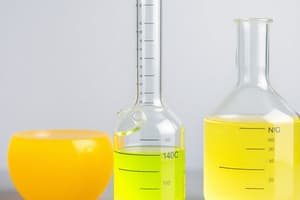Podcast
Questions and Answers
What characterizes an Arrhenius acid?
What characterizes an Arrhenius acid?
- Forms a covalent bond with bases
- Is only defined in gaseous states
- Releases H+ ions in solution (correct)
- Produces OH- ions in water
How does the Bronsted–Lowry definition of a base differ from that of Arrhenius?
How does the Bronsted–Lowry definition of a base differ from that of Arrhenius?
- It is restricted to specific reactions
- It only considers gas-phase reactions
- It applies to non-aqueous solutions (correct)
- It only includes hydroxide ions
What is an example of a monoprotic acid?
What is an example of a monoprotic acid?
- H3PO4
- HCl (correct)
- H2SO4
- H2CO3
Which of the following statements is true about polyprotic acids?
Which of the following statements is true about polyprotic acids?
In the reaction between NH3 and HCl, which component acts as a Bronsted–Lowry acid?
In the reaction between NH3 and HCl, which component acts as a Bronsted–Lowry acid?
Which of the following describes a Lewis acid?
Which of the following describes a Lewis acid?
What is the primary factor affecting the pH calculation of a monoprotic acid?
What is the primary factor affecting the pH calculation of a monoprotic acid?
What is the active species in the Bronsted–Lowry model of acid-base reactions?
What is the active species in the Bronsted–Lowry model of acid-base reactions?
Flashcards are hidden until you start studying
Study Notes
Arrhenius Acid-Base Theory
- Arrhenius defined acids as substances that produce hydrogen ions (H+) when dissolved in water.
- Arrhenius defined bases as substances that produce hydroxide ions (OH-) when dissolved in water.
Limitations of Arrhenius Theory
- The Arrhenius theory only applies to substances in aqueous solutions, doesn't account for reactions in other solvents.
- The theory only considers the production of H+ and OH- ions, limiting its applicability to substances that release these ions explicitly.
Bronsted-Lowry Acid-Base Theory
- The Bronsted-Lowry definition of an acid is similar to Arrhenius, but it is not limited to aqueous solutions.
- Bronsted-Lowry defines an acid as a proton donor (H+).
- Bronsted-Lowry defines a base as a proton acceptor (H+).
Lewis Acid-Base Theory
- The Lewis theory defines an acid as an electron pair acceptor.
- The Lewis theory defines a base as an electron pair donor.
Polyprotic Acids
- Polyprotic acids donate multiple protons per molecule.
- They have more than one ionizable H+ atom in their structure.
- Protons are released in stages, with the first proton being the easiest to remove.
Studying That Suits You
Use AI to generate personalized quizzes and flashcards to suit your learning preferences.




